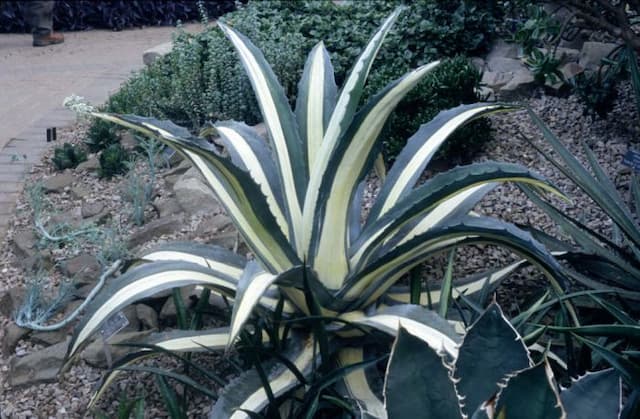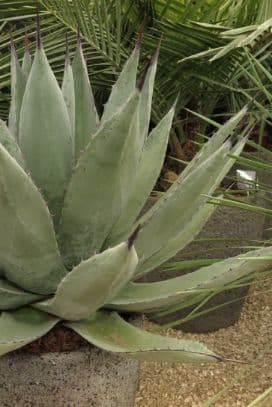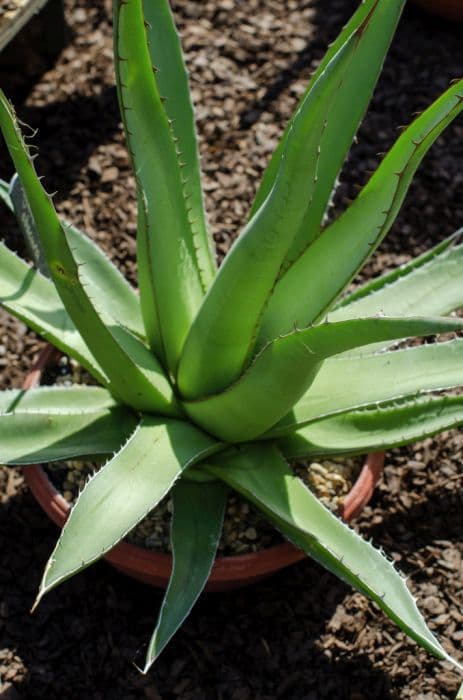Plantain Lily Hosta 'Little Caesar' (v)

ABOUT
Hosta 'Little Caesar' is a charming perennial primarily known for its decorative foliage. The plant boasts broad, heart-shaped leaves that have a rich, deep green color. These leaves often have a glossy appearance and may showcase slightly wavy edges that add to the overall texture of the plant. The leaf surface is relatively smooth, and in certain lights, the leaves may exhibit a subtle sheen. As the season progresses, 'Little Caesar' may produce flowering stems that rise above the foliage, bearing delicate bell-shaped flowers. The flowers are typically a soft lavender or pale purple color, contributing to the plant's ornamental appeal. The bloom stalks contrast nicely with the lush green foliage, attracting pollinators and adding a vertical element to the plant's visual display. Hosta 'Little Caesar' forms a mound-like clump that spreads outwards with its leaves layered over each other in a pleasing, dense mat. This characteristic shape makes it an excellent choice for ground cover in shaded garden areas, where its leaves can effectively suppress weeds and maintain soil moisture. The overall impression is that of a lush, verdant plant with a robust and healthy appearance, bringing a sense of tranquility and natural beauty to any garden setting it occupies.
About this plant
 Names
NamesFamily
Asparagaceae
Synonyms
Plantain Lily, Funkia
Common names
Hosta 'Little Caesar'
 Toxicity
ToxicityTo humans
Hostas, including the 'Little Caesar' variety, are not considered poisonous to humans. They are generally not consumed due to their unpalatable taste, but accidental ingestion is unlikely to cause harm beyond possible mild stomach discomfort. It's always sensible to exercise caution and avoid eating plants that are not specifically grown for consumption.
To pets
Hostas are toxic to pets, especially to cats and dogs. If your pet consumes any part of a Hosta ('Little Caesar' or otherwise), it might experience symptoms such as vomiting, diarrhea, and depression. In severe cases, ingestion can lead to more serious effects and veterinary attention should be sought. It's important to prevent pets from having access to these plants to ensure their safety.
 Characteristics
CharacteristicsLife cycle
Perennials
Foliage type
Deciduous
Color of leaves
Variegated
Flower color
Lavender
Height
1 foot (0.3 meters)
Spread
2 feet (0.61 meters)
Plant type
Herb
Hardiness zones
3
Native area
Asia
Benefits
 General Benefits
General Benefits- Attractive Foliage: Hosta 'Little Caesar' features lush green leaves that add texture and depth to garden designs.
- Shade Tolerance: This variety thrives in shaded areas where other plants might struggle, making it ideal for woodland gardens.
- Low Maintenance: Hostas are generally low maintenance, requiring minimal care once established.
- Long-Lived Perennial: Hostas are perennials, returning each year to add consistency to a garden setting.
- Ground Cover: Its dense foliage can help suppress weeds, reducing garden maintenance.
- Seasonal Interest: Hosta 'Little Caesar' can provide interest throughout the growing season with its foliage and blooms.
- Attracts Pollinators: Though not known for large flowers, the blooms can still attract bees and other pollinators.
- Drought Resistance: Once established, Hostas can tolerate periods of drought.
- Versatility: They can be used in a variety of garden designs, including borders, containers, and as specimen plants.
- Easy to Divide: Hostas can be easily divided to create more plants, making them cost-effective and easy to propagate.
 Medical Properties
Medical PropertiesThis plant is not used for medical purposes.
 Air-purifying Qualities
Air-purifying QualitiesThis plant is not specifically known for air purifying qualities.
 Other Uses
Other Uses- As a living mulch, Hostas can be planted under trees or shrubs to help retain soil moisture and reduce weed growth due to their dense foliage.
- Hosta leaves can be used as a natural platter or wrap for outdoor dining; their large leaves are perfect for holding finger foods or as a decorative base for fruit and cheese platters.
- Due to their texture and color, Hosta leaves can be used in craft projects, such as pressing for botanical prints or inclusion in handmade paper.
- Their blossoms can be added to floral arrangements to add a touch of greenery or as an unconventional flower in bouquets.
- Hostas can be used in educational settings for plant identification and horticulture training because of their distinct leaf shapes and growth habits.
- In garden design, different varieties of Hostas can be used to create patterns and mosaics in shade gardens due to their variety of leaf colors and patterns.
- Hosta shoots (young unfurled leaves) are edible and can be eaten as a spring vegetable in salads or cooked similarly to asparagus.
- They can serve as a natural dye source, where the leaves produce varying shades of green, depending on the specific variety of Hosta used.
- Hosta varieties like 'Little Caesar' can be planted in containers to create mobile shade spots on patios or decks where ground planting isn't possible.
- In photography and art, the interesting foliage of Hostas can serve as an excellent subject or backdrop for capturing texture and patterns in nature.
Interesting Facts
 Feng Shui
Feng ShuiThe Hosta is not used in Feng Shui practice.
 Zodiac Sign Compitability
Zodiac Sign CompitabilityThe Hosta is not used in astrology practice.
 Plant Symbolism
Plant Symbolism- Resilience: The Hosta plant, often known as the plantain lily, can thrive in shade, symbolizing the ability to persevere and adapt in less than ideal circumstances.
- Devotion: With its lush foliage that returns and expands each year, the plantain lily signifies devotion and loyalty in relationships.
- Friendship: Hostas are often shared among gardening friends, making them a symbol of friendship and community spirit.
- Beauty: The plantain lily's attractive leaves and delicate flowers represent appreciation of beauty, regardless of the surroundings.
- Peace: The cool and calming hues of the Hosta’s leaves embody tranquility and peace, making it a plant typically found in serene garden spaces.
 Water
WaterThe Hosta, commonly known as plantain lily, should be watered deeply once a week, allowing the soil to become slightly dry between waterings. In general, one inch of water per week, including rainfall, is sufficient. During hot or dry periods, you may need to water twice a week. Ensure water penetrates the soil to reach the roots rather than just wetting the surface. For potted Hosta 'Little Caesar', check the top inch of soil for dryness and water thoroughly until it runs out of the drainage holes, which might equate to about half a gallon for a standard-sized pot.
 Light
LightPlantain lilies thrive best in partial to full shade. They should be positioned in a spot where they receive morning light and are protected from the intense afternoon sun. A location under a tree that provides dappled sunlight throughout the day is ideal. Too much direct sun can burn the leaves, so ensuring adequate shade is essential for their growth and leaf coloration.
 Temperature
TemperatureThe ideal temperature range for the plantain lily is between 50°F and 75°F. While Hosta 'Little Caesar' can tolerate temperatures as low as 30°F, it is important to avoid exposing them to hard frosts. They can also handle temperatures up to around 90°F, but prolonged heat can stress the plants. Mulching can help maintain a consistent soil temperature and protect the roots.
 Pruning
PruningPruning plantain lilies is mostly to remove the spent flowers or any damaged or yellowing leaves to improve the plant's appearance and prevent disease. It's best to prune in late fall or early spring before new growth begins. Pruning is not often required but doing it annually during these times can promote healthier growth and better foliage.
 Cleaning
CleaningAs needed
 Soil
SoilHostas, also known as Plantain Lilies, thrive in a soil mix comprising equal parts of loam, peat moss, and perlite, which provides aeration and moisture retention. The ideal pH for Hostas 'Little Caesar' is between 6.0 and 7.5, slightly acidic to neutral.
 Repotting
RepottingHosta 'Little Caesar' should be repotted every few years or when it becomes root-bound. Generally, repotting every 3 to 5 years is sufficient for maintaining healthy growth.
 Humidity & Misting
Humidity & MistingHosta 'Little Caesar' prefers average to high humidity levels but is quite adaptable. The ideal humidity range is around 50-75%.
 Suitable locations
Suitable locationsIndoor
Place in filtered light, keep soil moist, not wet.
Outdoor
Plant in partial shade, in well-drained, fertile soil.
Hardiness zone
3-9 USDA
 Life cycle
Life cycleHosta 'Little Caesar', commonly known as plantain lily, begins its life as a seed, but is often purchased and grown from a root division or rhizome. After planting, it enters a vegetative growth stage in the spring where foliage emerges from the soil and forms characteristic mounds of heart-shaped leaves. As it matures, the plantain lily produces stalks topped with bell-shaped flowers, typically in mid-summer, which can attract pollinators such as bees. Following the flowering period, the plant may produce seeds, although propagation is usually through division. As temperatures drop in the fall, the leaves will die back and the plant will enter a period of dormancy through the winter months. With the return of warmer spring weather, the Hosta 'Little Caesar' will re-emerge from its dormant state and begin a new growth cycle.
 Propogation
PropogationPropogation time
Early spring
Hosta 'Little Caesar', commonly known as plantain lily, is typically propagated through division. The best time to divide hostas is in early spring or early fall, when the plant is not in active growth. To propagate 'Little Caesar', carefully dig up the entire clump and gently separate it into smaller sections, ensuring that each section has at least two or three shoots and ample root system. Replant the divisions at the same soil level as they were previously growing. Water the new plantings thoroughly to establish them. This method not only helps to propagate the plant but also invigorates older clumps that may have become too crowded.









